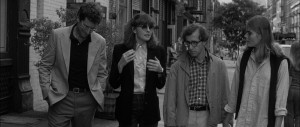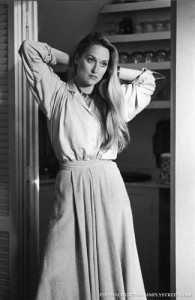Woody Allen Classic Movie Mondays: Manhattan
Universally praised by critics and a favorite among Woody Allen fans,Manhattan (1979) remains one of the key films of the seventies, one that is still relevant and astute in its observations of life in Gotham. In Woody Allen’s own words, it is about ‘the problems of trying to live a decent life amidst the junk of contemporary culture – the temptations, the seductions.’ It is also uncharacteristically romantic for an Allen movie with its “May-December” affair between Isaac Davis (Allen), a twice-divorced 42-year-old comedy writer, and Tracy (Mariel Hemingway), a 17-year-old high school student. Equally important is the city of New York which plays a central role in the film. This is not the grimy, gritty Big Apple glimpsed in the films of Martin Scorcese (Mean Streets, 1972), Sidney Lumet (Serpico, 1973), or Abel Ferrara (Bad Lieutenant, 1992). This is an idealized view of the city which travels from the Central Park to the Russian Tea Room to the Hayden Planetarium with stops at the Guggenheim, the Whitney, and other cultural landmarks. Allen said, “I presented a view of the city as I’d like it to be and as it can be today, if you take the trouble to walk on the right streets.”
In a conversation with Silvio Bizio, the director revealed that the idea for Manhattan ”evolved from the music. I was listening to a record album of overtures from famous George Gershwin shows, and I thought ‘This would be a beautiful thing to make a movie in black-and-white, you know, and make a romantic movie.” United Artists initially had some reservations about allowing Allen to shoot in monochrome due to commercial considerations but eventually gave in to his demands. Allen promptly hired cinematographer Gordon Willis who decided the best way to capture New York City was in the wide-screen Panavision process. It proved to be an inspired creative decision which is evident from the exhilarating opening montage set to Gershwin’s “Rhapsody in Blue.”
When Manhattan was first released, there was some criticism leveled at the film for its depiction of a romance between a teenager and a 42-year-old man but several biographical sources have suggested that the relationship had a real-life parallel in Allen’s two-year romance with actress Stacey Nelkin (Halloween III: Season of the Witch, 1983). Reportedly, Allen met Nelkin on the set of Annie Hall (1977) when she was a mere 17-year-old extra (Her small part ended up on the cutting room floor). Certain aspects of the Isaac-Tracy relationship may also have been inspired by Allen’s real-life correspondence with 13-year-old pen pal, Nancy Jo Sales.
Cast in the role of Tracy, Mariel Hemingway surprised critics with her appealing, unself-conscious performance. It was only her second film (Her first was a supporting role in Lipstick (1976), an exploitation thriller starring her sister, Margaux) and she received an Oscar nomination for Best Supporting Actress. Coincidentally, she lost to Meryl Streep for Kramer vs. Kramer who also appeared in Manhattan as a bisexual feminist and former wife of Isaac Davis. Manhattan is also notable as Diane Keaton’s last appearance in an Allen film untilManhattan Murder Mystery (1993) and some of the more interesting cameos include US Congresswoman Bella Abzug as herself, New York Magazine critic Judith Crist, Anne Byrne, ex-wife of Dustin Hoffman, Karen Allen as a TV actress, and Tisa Farrow, the sister of Mia.
Although it’s hard to believe now, Allen admitted he was so appalled by Manhattan after completing it that he had his agent Sam Cohn offer United Artists another film for nothing if they would not release it. Luckily, he changed his mind shortly thereafter but Allen has always been his own worst critic. The majority view of the film is perhaps best expressed by critic Tom Milne who wrote “it’s funny and sad in exactly the right proportions. Allen could well strive vainly ever to better this film.”






